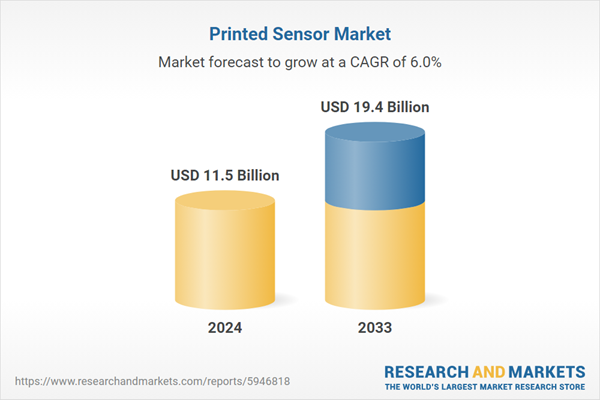Printed sensors are electronic sensors that can be manufactured using printing techniques, including inkjet printing, screen printing, or flexography. These sensors are printed on flexible substrates, such as plastic, paper, or textiles, using conductive and non-conductive inks. They can be used for sensing responses, occurrences, or changes in temperature, humidity, pressure, strain, and chemicals. They can also be developed for biosensors to detect biomolecules such as glucose, proteins, and deoxyribonucleic acid (DNA). Apart from this, printed sensors are lightweight, flexible, and cost-effective, making them ideal for several applications in wearable devices, smart packaging, and medical devices.
Printed Sensor Market Trends:
The increasing integration of printed sensors in wearable medical devices to enable real-time monitoring of vital signs, such as glucose, blood pressure, and oxygen levels, and improve patient outcomes represents the key factor driving the market growth. Moreover, the largescale product utilization across smart and portable electronic products, such as smartwatches, activity-tracking bands, foldable smartphones, and laptops, is creating a positive outlook for the market. In line with this, the increasing demand for advanced security features, including gesture and face recognition and fingerprint authentication in consumer devices, is aiding in market expansion. In addition to this, the widespread product adoption across the packaging industry for smart labeling is providing remunerative growth opportunities for the market. Besides this, the surging demand for Internet of Things (IoT) applications, wherein printed sensors are used to enable features, such as motion detection, temperature monitoring, and pressure sensing, represents another significant growth-inducing factor. Furthermore, the escalating demand for smart homes, the rising number of smart city projects, and favorable government initiatives are contributing to the market growth. Concurrent with this, the advent of miniaturized electronic devices, the expanding demand for flexible and thin interactive displays, the increasing focus on energy efficiency, and significant advancements in three-dimensional (3D) printing are impelling the market growth.Key Market Segmentation:
The publisher provides an analysis of the key trends in each segment of the global printed sensor market, along with forecasts at the global, regional, and country levels from 2025-2033. Our report has categorized the market based on type, printing technology, and application.Type Insights:
- Printed Biosensor
- Printed Touch Sensor
- Printed Gas Sensor
- Printed Humidity Sensor
- Printed Image Sensor
- Printed Pressure Sensor
- Printed Temperature Sensor
- Printed Proximity Sensor
Printing Technology Insights:
- Gravure Printing
- Inkjet Printing
- Screen Printing
- Others
Application Insights:
- Automotive
- Consumer Electronics
- Environmental Testing
- Industrial Equipment
- Medical Devices
- Building Automation
- Smart Packaging
- Others
Regional Insights:
- North America
- United States
- Canada
- Asia Pacific
- China
- Japan
- India
- South Korea
- Australia
- Indonesia
- Others
- Europe
- Germany
- France
- United Kingdom
- Italy
- Spain
- Russia
- Others
- Latin America
- Brazil
- Mexico
- Others
- Middle East and Africa
Competitive Landscape:
The report has also provided a comprehensive analysis of the competitive landscape in the global printed sensor market. Detailed profiles of all major companies have also been provided. Some of the companies covered include Canatu Oy, Interlink Electronics, ISORG, KWJ Engineering, Nissha Co. Ltd., Peratech Holdco Limited, PolyIC GmbH & Co.KG (LEONHARD KURZ Stiftung & Co. KG), PST Sensors, Sensitronics LLC, Tekscan, etc. Kindly note that this only represents a partial list of companies, and the complete list has been provided in the report.Key Questions Answered in This Report:
How has the global printed sensor market performed so far, and how will it perform in the coming years?What are the drivers, restraints, and opportunities in the global printed sensor market?
What is the impact of each driver, restraint, and opportunity on the global printed sensor market?
What are the key regional markets?
Which countries represent the most attractive printed sensor market?
What is the breakup of the market based on the type?
Which is the most attractive type in the printed sensor market?
What is the breakup of the market based on printing technology?
Which is the most attractive printing technology in the printed sensor market?
What is the breakup of the market based on the application?
Which is the most attractive application in the printed sensor market?
What is the competitive structure of the global printed sensor market?
Who are the key players/companies in the global printed sensor market?
Table of Contents
Companies Mentioned
- Canatu Oy
- Interlink Electronics
- ISORG
- KWJ Engineering
- Nissha Co. Ltd.
- Peratech Holdco Limited
- PolyIC GmbH & Co.KG (LEONHARD KURZ Stiftung & Co. KG)
- PST Sensors
- Sensitronics LLC
- Tekscan
Methodology

LOADING...
Table Information
| Report Attribute | Details |
|---|---|
| No. of Pages | 132 |
| Published | January 2025 |
| Forecast Period | 2024 - 2033 |
| Estimated Market Value ( USD | $ 11.5 Billion |
| Forecasted Market Value ( USD | $ 19.4 Billion |
| Compound Annual Growth Rate | 6.0% |
| Regions Covered | Global |
| No. of Companies Mentioned | 10 |









